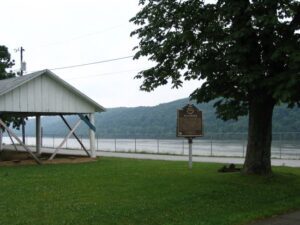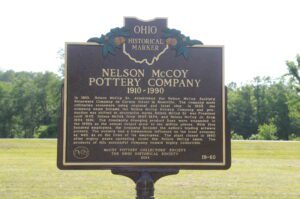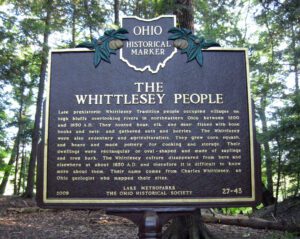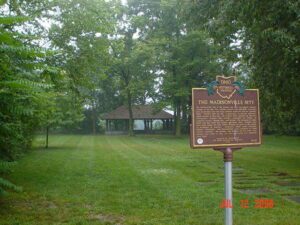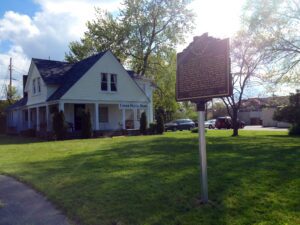, OH
Manchester was founded in 1791 by Nathaniel Massie as a base to survey the land warrants of American Revolutionary War soldiers in the Virginia Military District. This bank of the Ohio River provided a secure site for the last civilian stockade built in Ohio. The natural protection of this fortification included marshland to the west and north and the river on the south. The nearby three islands provided a safe place for retreat in dangerous circumstances and also supplied an area to raise food in its rich bottomlands. The invention of the steam powered paddle wheel boat allowed the river to become the city’s main source of shipping and commerce in the nineteenth century. Manchester was an important port of call for provisions; the export of agricultural products; and the manufacture of goods such as pottery, furniture, and leather goods.
, OH
In 1910, Nelson McCoy Sr. established the Neleson McCoy Sanitary Stoneware Company on Gordon Street in Roseville. The company made utilitarian stoneware using regional and local clay. In 1933, the company name became the Nelson McCoy Pottery Company and production was shifted to decorative wares. Nelson McCoy Sr. was President until 1945, Nelson Melick from 1945-1954, and Nelson McCoy Jr. from 1954-1981. The constantly changing product lines were expanded in the 1950s as the annual output grew to ten million pieces. WIth five hundred employees, the company became the nation’s leading artware pottery. The pottery had a tremendous influence on the local economy as well as on the lives of its employees. The plant closed in 1990 after eighty years operating under the Nelson McCoy name. The products of this successful company remain highly collectible.
, OH
The Indian Point Site contains the remains of a prehistoric Native American earthen enclosure, officially known as the Lyman site, named after a former property owner. The site contains two earthen walls that are bordered by ditches. Steep cliffs provide natural barriers on two sides of the enclosure. Archaeological digs have uncovered many artifacts here, including pottery sherds, tools, pipes, and beads. There is evidence that the walls were built around 140 B.C., and the site was occupied again around 1500 A.D. by the Whittlesey Tradition people. It is uncertain if the site was a village or was used as a ceremonial center. After 1650 A.D., the area became a neutral hunting ground for various historic tribes.
, OH
The Madisonville site is the largest and most thoroughly studied village of the late Fort Ancient culture (AD 1450 – 1670). Artifacts were so abundant here that local residents called this site the “pottery field.” Between 1879 and 1911, a generation of Harvard archaeologists trained at this site. Dr. Charles Metz, assisted by Harvard University’s Frederic Ward Putnam, excavated the remains of numerous houses, storage pits, and burials. The presence of glass beads and bits from iron kettles indicates these villagers may have been among the first native Ohioans to learn of the coming of Europeans to America. Mariemont street names Cachepit, Midden, Flintpoint, and Hammerstone, are reminders of these earlier residents. The pavilion was designed by the noted town planner John Nolen in 1921, but not constructed and dedicated until 2001.
, OH
At this location, in 1913, R. Guy Cowan opened Northeast Ohio’s only art pottery, the Cowan Pottery Studio (known first as the Cleveland Pottery and Tile Company). Cowan began molding Lakewood’s clay into sculptural forms covered with unique glazes. Cowan’s venture depended on the commercial success of his tiles, which adorned homes and community institutions throughout greater Cleveland. By 1917, his Lakewood Ware had achieved international recognition with an ward from the Art Institute of Chicago. After his World War I service, Cowan returned to Lakewood, where a drained gas well prompted the pottery’s relocation to Rocky River. Until the pottery closed in 1931, a casualty of the Great Depression, its artists produced elegant household wares and limited-edition ceramic sculptures that were sold throughout the United States and Canada.
, OH
With work inspired by mythology, literature, religion and nature, Cowan Pottery played a significant role in the formative years of American ceramic art and established a national following with products sold in fine department stores. The design studio, factory and showroom of Cowan Pottery stood here from 1920-1931. R. Guy Cowan moved the business to Rocky River from Lakewood, where it started in 1913. Although Cowan Pottery closed during the Depression, the firm’s work is still collected and can be found in the Smithsonian, Cleveland Museum of Art and other museums. Comprehensive holdings are in the Cowan Pottery Museum at the Rocky River Public Library.


